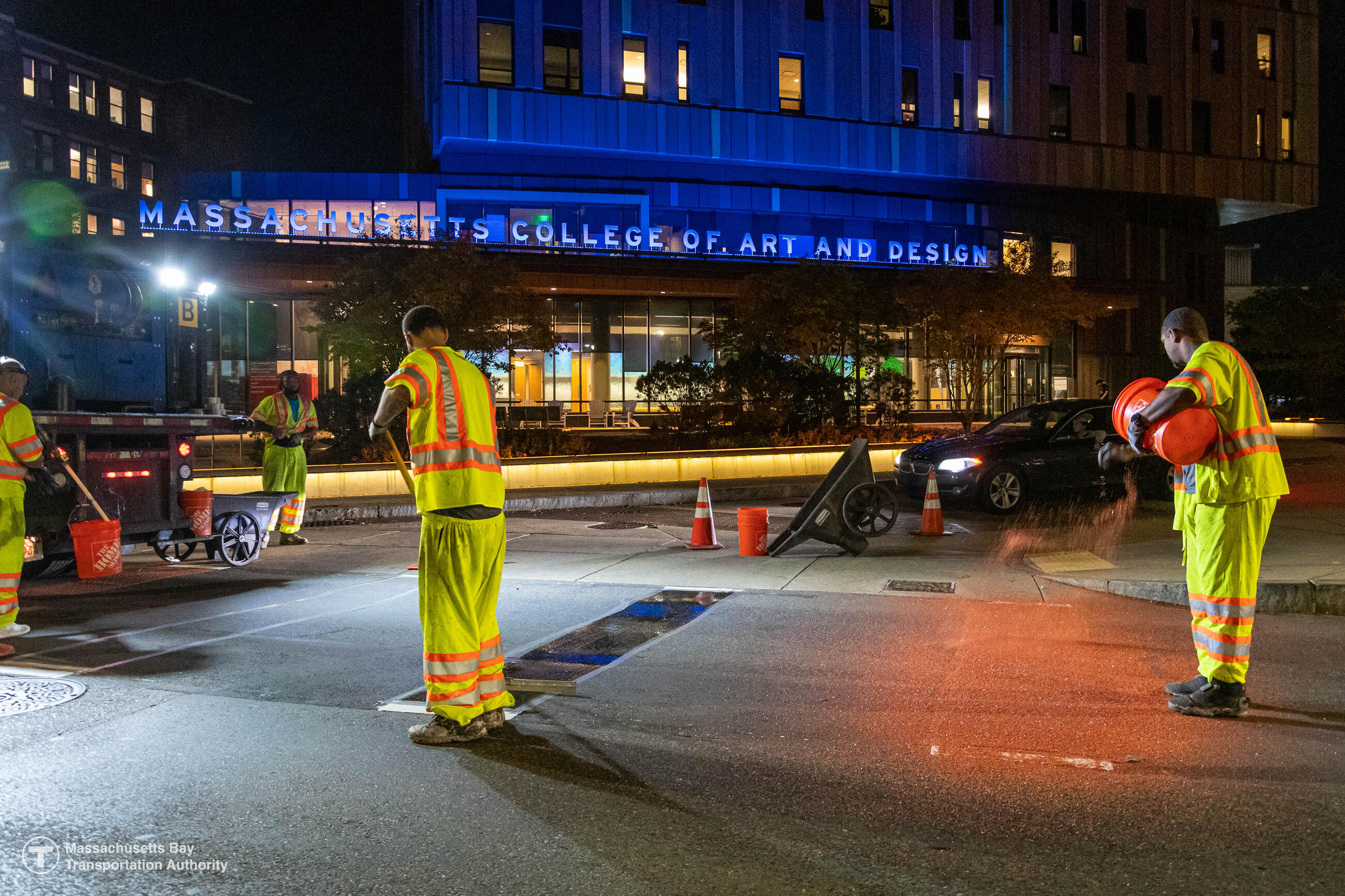Data Reveals Time Savings from Quick-Build Huntington Avenue Bus Lanes; MBTA and The City of Boston Announce Upcoming Striping Work to Complete Permanent Huntington Avenue Bus-Bike Lanes to Improve Transit for Thousands of Bus Riders
Posted on September 25, 2023
Quick-build bus-bike lanes along Huntington Avenue deployed to support the month-long Orange Line shutdown last fall have resulted in time-savings for bus riders on Routes 39 and CT2; MBTA and City of Boston to complete work on shared bus-bike lanes on Huntington Avenue this fall.

The MBTA and City of Boston today announced upcoming roadway striping to complete the Huntington Avenue shared bus-bike lanes between Brigham Circle and Gainsborough Street in Boston. An initial phase of striping work, which was expedited last year to help mitigate regional mobility impacts from the MBTA’s month-long Orange Line closure last year, has already yielded considerable time-savings for bus transit riders.
In a preliminary evaluation of the shared bus-bikes lanes along Huntington Avenue between Brigham Circle and Gainsborough Street, the Boston Transportation Department (BTD) and the MBTA found that Bus Route 39 and CT2 riders are saving up to two minutes per trip during evening and morning rush hours compared to the same period in 2019 before the COVID-19 pandemic, according to an MBTA analysis. This adds up to a total time-savings of 125 hours for bus riders every work week along the approximately mile-long corridor, providing better mobility for nearly 5,000 daily trips. The City of Boston and MBTA expect that the completion of the shared bus-bike lane markings this year should make the lanes more clear to road-users and improve overall compliance.
“This project shows how the MBTA can efficiently and effectively implement meaningful measures that improve bus service and reliability for thousands of transit riders in partnership with municipalities,” said MBTA General Manager and CEO Phillip Eng. “I want to thank the T’s Bus Transformation staff for their dedicated efforts on this project, and BTD and the City for continuing to collaborate with us on bus lanes and improvements, which benefit so many.”
In addition to the time savings for bus riders, the evaluation showed that the quick-build lanes have coincided with improved traffic safety conditions. Project implementation has coincided with slightly lower speeds along the corridor, providing safer conditions for all road users. While bus riders are experiencing time savings of up to two minutes per trip since the first wave of implementation last year, BTD’s analysis found that the average one-way automobile travel times on the corridor have increased by less than 45 seconds.
“This project demonstrates the benefits of rebalancing our street space to prioritize transit,” said Boston Chief of Streets Jascha Franklin-Hodge. “Dedicated bus lanes save bus riders time and are one of the most effective ways that the City can improve transit and make it a more convenient and reliable option for our residents.”
The MBTA and City of Boston will be completing the roadway markings for the new lanes during this fall’s construction season by finishing painting the existing bus-bike lanes with additional red paint. Work is expected to start imminently and is expected to last several weeks, weather depending. Additionally, the City of Boston will be finalizing bus lane markings for several streets around Copley Square, which Mayor Michelle Wu announced after the end of the Orange Line shutdown last fall.
Building on the successes of the Huntington Avenue bus-bike lanes, BTD, in partnership with the MBTA, is leading a process to look at the entirety of the Route 39 bus from Forest Hills Station to Back Bay Station. The Route 39 Transit Priority Corridor Project will further identify other opportunities to improve transit reliability and pedestrian safety along the route with a first phase of implementation slated for sometime in 2024. Community engagement will begin over the next few months and will be key to informing the study’s findings and recommendations.
The building of infrastructure to support public transportation and bicyclists builds off of Mayor Wu’s commitment to reimagining City streets and making all forms of transportation safer and more convenient. Late last year, Mayor Wu announced a 9.4-mile expansion of bike lanes providing key connections within the City’s existing bike network and the launch of a Citywide design process to bring safer streets to every neighborhood.
The MBTA Transit Priority Group is part of the Better Bus Project which aims to transform bus service throughout the MBTA system and is responsible for designing and implementing bus priority infrastructure. The group works closely with the City of Boston, other municipal partners, and fellow state agencies. To date, the group has delivered over 40 miles of bus lanes and activated transit signal priority at 85 locations in 12 municipalities.
The BTD Transit Team works within the Policy and Planning group in the Streets Cabinet to improve transit service wherever it hits City streets. Their work spans from quick-build, targeted interventions to full-scale corridor redesigns to ensure that all Bostonians, regardless of how they travel, are able to get around safely, efficiently, and equitably.
More Information
Media Contact Information
For all queries and comments, please contact:
Recent News on the T
April 18, 2024
April 18, 2024
April 18, 2024
April 16, 2024